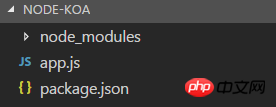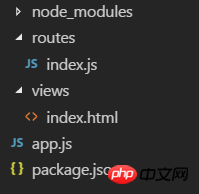
Nowadays, many front-end engineers pay more attention to new technologies such as NodeJs and express framework or Koa framework. It's rare that I have a lot of free time recently, so I took advantage of this free time before the Lunar New Year has officially arrived to get involved in it and get a glimpse of its secrets.
Koa is an ultra-lightweight server-side framework created by the original team of Express
Compared with Express, in addition to having a higher degree of freedom and being able to introduce middleware by yourself, more importantly ES6 async is used to avoid callback hell
But it is also due to code upgrades, so Koa2 requires a node.js environment of v7.60 or above
Manually create a project directory, and then quickly generate a package.json file
npm init -y
Install koa //The current version is 2.4.1
npm install koa -S
Then create an app.js
// app.js const Koa = require('koa'); const app = new Koa(); app.use(async ctx => { ctx.body = 'Wise Wrong'; }); app.listen(3000);
Finally, add the startup command in package.json

A most basic koa application is completed

Okay Execute npm start and visit http://localhost:3000/ in the browser to view the effect
If you feel that manually creating the project is too cumbersome, you can use the scaffolding koa-generato to generate the project
npm install koa-generator -g
koa2 project_name
Then Under the project, npm install installs the dependencies, and npm start starts the project
If you are new to koa, it is recommended to read this blog first, and then use the scaffolding tool, so that you can better understand the role of each dependent package
There is a ctx in app.js above, which is a Context object provided by Koa, encapsulating request and response
Every HTTP Request will create a Context object
We can get the path requested by the user through Context.request.path, and then send content to the user through Context.response.body
Koa’s default return type is text/plain. If you want to return an html file (or a module file), you need to modify Context.response.type
In addition, Context.response can be abbreviated, for example, Context.response.type is abbreviated to Context.type, Context.response .body is abbreviated as Context.type
Create a directory views under the project to store html files, and create an index.html in this directory, then modify app.js
// app.js// 原生路由 const Koa = require('koa'); const fs = require('fs'); const app = new Koa(); app.use(async (ctx, next) => { if (ctx.request.path === '/index') { ctx.type = 'text/html'; ctx.body = fs.createReadStream('./views/index.html'); } else { await next(); } }); app.listen(3000);
and then When you access http://localhost:3000/index in the browser, you can see the index.html page, but when you access other addresses, it is not found
. It seems very clumsy to handle the URL in this way, so we need to introduce routing intermediate koa-router
npm install koa-router -S
It should be noted that when importing koa-router, you need to add a bracket at the end:
const router = require('koa-router')();
is equivalent to:
const koaRouter = require('koa-router'); const router = koaRouter();
Create a routes directory, used to store routing files and create index.js

// routes/index.js const fs = require('fs'); const router = require('koa-router')() router.get('/index', async (ctx, next) => { ctx.type = 'text/html'; ctx.body = fs.createReadStream('./views/index.html'); }); module.exports = router
You can also use the prefix method here to add a baseUrl# for all interfaces in the file.
##// router.prefix('/about') Modify app.js// app.js const Koa = require('koa'); const app = new Koa(); const index = require('./routes/index') app.use(index.routes(), index.allowedMethods()) app.listen(3000);
router.get('/about/:name', async (ctx, next) => { ctx.body = `I am ${ctx.params.name}!`; });
npm install koa-static -S

const static = require('koa-static'); // 将 public 目录设置为静态资源目录 const main = static(__dirname + '/public'); app.use(main);
app.use(require('koa-static')(__dirname + '/public'));

npm install koa-views -S
const views = require('koa-views') app.use(views(__dirname + '/views'));
// routes/index.js const router = require('koa-router')() router.get('/index', async (ctx, next) => { await ctx.render('index'); }); module.exports = router
app.use(views(__dirname + '/views', { extension: 'pug' // 以 pug 模版为例 }))
As mentioned in the article, starting from scratch is too cumbersome. You can use the scaffolding koa-generato to develop quickly
But I recommend that after getting familiar with Koa, build a scaffolding suitable for your own project
The above is what I compiled for everyone. I hope it will be helpful to everyone in the future.
Related articles:
Comparison of the use of express and koa (detailed tutorial)
The first use of stylus installation method in vue (detailed tutorial Tutorial)
Development of goods components in Vue framework
The above is the detailed content of Use Koa to build projects through Node.js. For more information, please follow other related articles on the PHP Chinese website!




